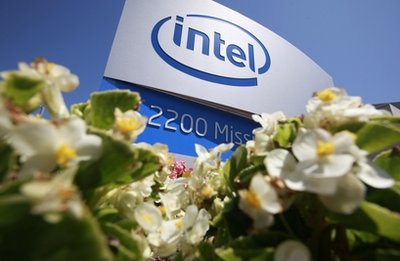 Intel Corp. has posted its largest quarterly net income in a decade as the company benefits from a strengthening computer market and more sophisticated factories.
Intel Corp. has posted its largest quarterly net income in a decade as the company benefits from a strengthening computer market and more sophisticated factories.
An encouraging sign for the economy was that large corporations, which have been slower than consumers to start spending again after the worst of the recession passed, bought more computers that use Intel’s most expensive chips.
That suggests businesses are freeing up their technology budgets, which should have helped other companies as well. Intel’s main rival, Advanced Micro Devices Inc., reports on Thursday, while IBM Corp. and Microsoft Corp. issue results next week.
Intel’s results, reported after the market closed Tuesday, topped Wall Street’s forecasts, and the company raised its guidance. Shares of the company rose nearly 7 percent in extended trading.
Intel’s net income was $2.89 billion, or 51 cents per share, in the quarter ended June 26. That compares with a loss of $398 million, or 7 cents per share, a year ago, when Intel was forced to pay a $1.45 billion fine in Europe over antitrust violations.
Analysts expected net income of 43 cents per share in the latest period.
The last time Intel’s quarterly net income topped $2.5 billion was in 2000 during the dot-com heyday, when Internet fever fueled spectacular computer sales.
Revenue was $10.77 billion in the latest period, above the $10.25 billion expected by analysts surveyed by Thomson Reuters.
Intel’s third-quarter forecast was stronger than expected. Intel expects revenue of $11.20 billion to $12 billion. Analysts were projecting $10.92 billion.
Intel’s profit forecast also got a lift. Intel now expects gross profit margin — a key measure of a company’s ability to control costs — of 64 percent to 68 percent of revenue. Its previous forecast was for 62 percent to 66 percent.
The results point to robust spending on computers that use Intel’s chips. Intel is the world’s No. 1 maker of microprocessors, the “brains” of personal computers and servers.
Consumer spending on discounted PCs has been a major help to Intel over the past year and a half. More recently, corporate spending on computer servers also came back, but many companies have been stingy about upgrading their work forces’ PCs amid lingering fears about the health of their businesses.
Spending on PCs is critically important to Intel because the company gets the bulk of its profit from the sale of chips that go into PCs.
Intel’s profits have also risen because of technological upgrades to its factories that make its chips more powerful and cheaper to make. That’s a major factor in Intel’s ability to increase its profit margins.
The PC industry has been slowly recovering since a disastrous slump.
It has been more than a year since Intel CEO Paul Otellini declared that PC sales had “bottomed out” and were starting to recover after their worst stretch in six years.
His analysis was accurate, but the semiconductor business is highly cyclical and now many analysts worry that another slowdown could be around the corner. The fears are being stoked by economic wobbliness in Europe and signs of slowing demand in China.
More than half of Intel’s revenue comes from Europe and the Asia-Pacific region.
Still, market research firms IDC and Gartner Inc. predict that PC shipments will grow a robust 20 percent this year.
Shares of Intel, which is based in Santa Clara, rose $1.42, or 6.8 percent, to $22.43 in extended trading. In regular trading earlier, it jumped 44 cents, or 2.1 percent, to close at $21.01.
Editors' Recommendations
- Intel finally responds to CPU instability but only makes it more confusing
- What to do if your Intel CPU keeps crashing
- No, Intel isn’t blaming motherboard makers for instability issues
- Intel Battlemage graphics cards: release date speculation, price, specs, and more
- Intel’s big bet on efficient GPUs might actually work


